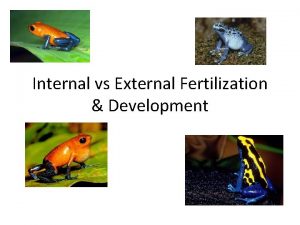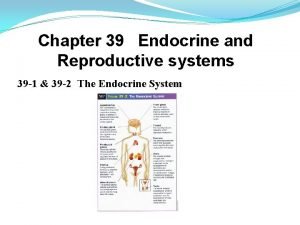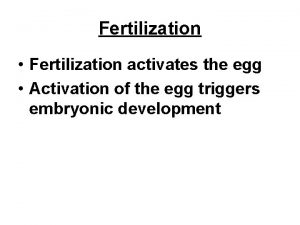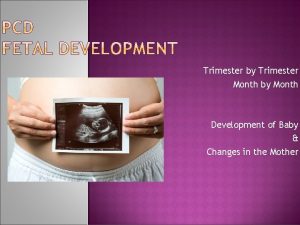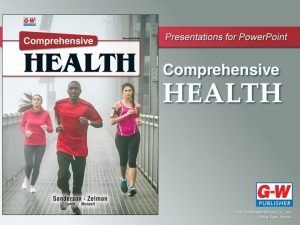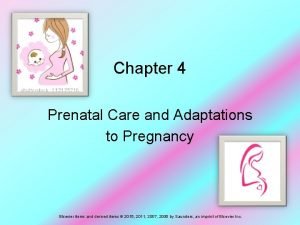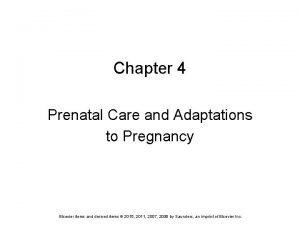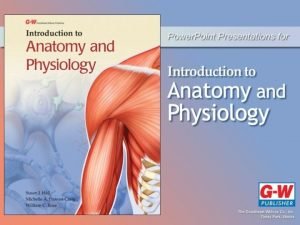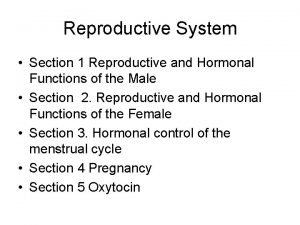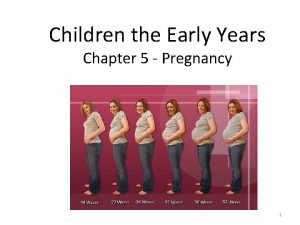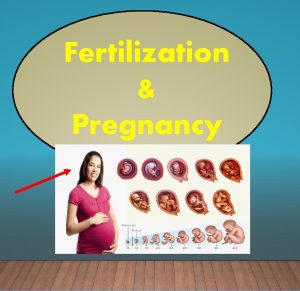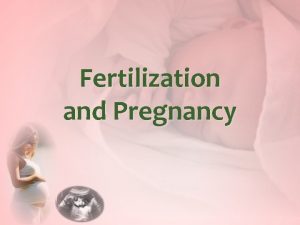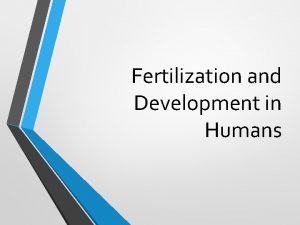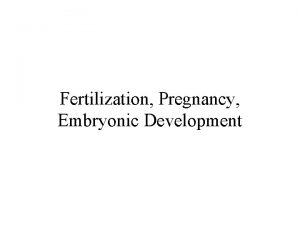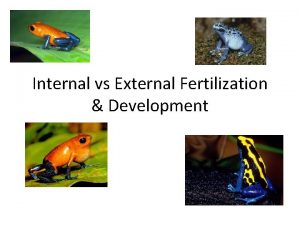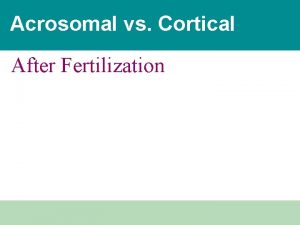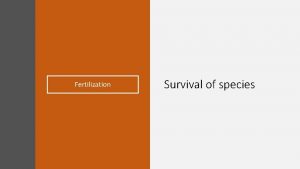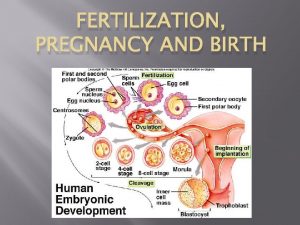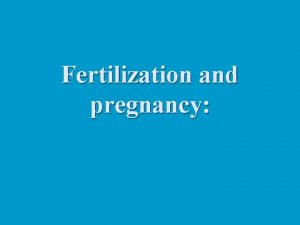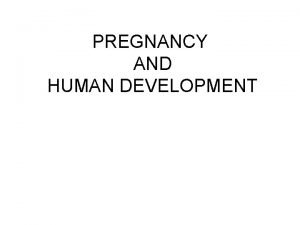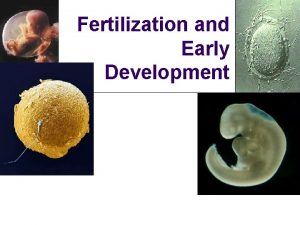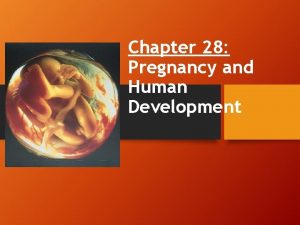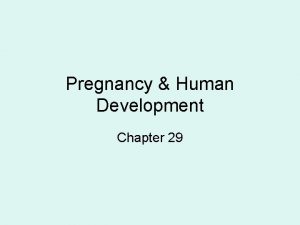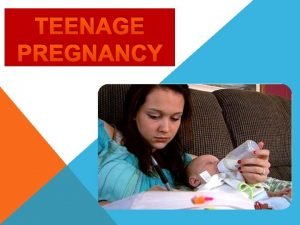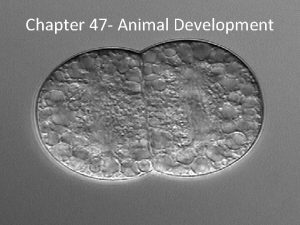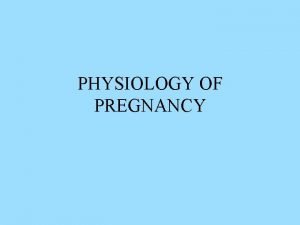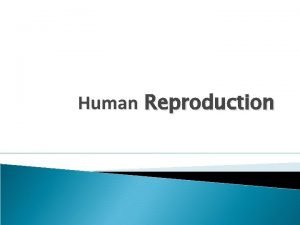Chapter 28 Pregnancy and Human Development Outline Fertilization




















- Slides: 20

Chapter 28: Pregnancy and Human Development Outline: • Fertilization (28. 1) • Implantation (28. 2 -28. 3) • Development (28. 4) • Childbirth (28. 6) • Lactation (28. 8) http: //www. indoreinfertilityclinic. com 1

Ch. 28: Test Question Templates • Q 1. Given a structure, identify which (if any) of the following steps of reproduction could be impaired by blockages of that structure: (A) passage of sperm through the male reproductive system; (B) passage of sperm through the female reproductive system; (C) passage of an unfertilized but viable oocyte through the female reproductive system; (D) passage of a fertilized oocyte/embryo through the female reproductive system; (E) delivery of a fetus from the womb. In addition, explain whether in vitro fertilization (IVF) would be likely to overcome infertility stemming from a blockage at the given structure. • Example: Jennifer and her partner are hoping to have a child. Jennifer’s uterine tubes are scarred and partly occluded. Which step(s) of “normal” reproduction may be directly impaired by this issue? In this case, would in vitro fertilization (IVF) be a good means of overcoming infertility? • Q 2. Given an alteration in a fetal circulatory vessel, predict the effects on blood flow. • Example: Jennifer is now pregnant. Her fetus has a narrower ductus arteriosus than usual. How will this narrowness affect the distribution of blood flow? 2

• Q 3. Given a detailed diagram of the hormonal induction of labor (covering the roles of oxytocin and prostaglandins), answer questions about the diagram. • Example. Given the enclosed diagram, explain how the nervous system and the endocrine system work together to force the baby out of the uterus. Figure by Subin Hyunh – adapted from Figure 28. 16 of Marieb & Hoehn (2019) 3

Fertilization maze: help the sperm find the oocyte! (1) Male structures sperm pass through: Martini et al. (2015), Figures 28 -1 & 28 -13 (2) Female structures sperm pass through: 4

Fertilization up close Q 1. Label the 2 layers through which the sperm is burrowing to get to the oocyte. Q 2. How does the sperm get through? Q 3. Two things happen in the 2 nd picture to prevent polyspermy. What are they? Q 4. What will happen to the sperm nucleus after the 2 nd picture? Marieb & Hoehn (2019), Focus Figure 28. 1 Q 5. Is each sperm competing against all others? 5

Ovulation to implantation Q 1. How many days after ovulation does fertilization usually occur? Q 2. How many days after that does implantation begin (if it happens)? Q 3. Pregnancy tests are based on h. CG produced by the chorion, which begins ~2 days after implantation. So when could a woman first test positive for pregnancy? Marieb & Hoehn (2019), Figure 28. 4 6

Back to infertility (male OR female) Possible treatment: In Vitro Fertilization (IVF) • Get LOTS of oocytes ready to ovulate • Retrieve oocytes just before ovulation • Mix with sperm in lab • Put embryo into uterus a. low sperm count? c. low b. vasectomy? oocyte supply? d. Fallopian tube block? e. uterus malformed? Q 1. Can this problem be overcome by IVF? http: //www. indoreinfertilityclinic. com 7

Early embryonic development: the 3 germ layers 12 days Marieb & Hoehn (2019), Figures 28. 9 & 28. 13 8

Questions on early embryonic development Q 1. Based on the previous slide, which of the 3 germ layers give(s) rise to each of the 4 tissue types? (Connect them with arrows. ) ectoderm mesoderm endoderm epithelial connective muscle nervous Q 2. Cardiac and renal defects tend to occur together in newborns, as do skin and nervous disorders. Why? Questions adapted from P. J. P. Brown (2016) 9

The placenta: nutrient/waste exchange Fundamental challenge: baby has no direct connection to outside world, but needs nutrients and needs to get rid of waste! Q 1. The placenta includes both fetal and maternal structures. Label the fetal and maternal sides. Q 2. How many umbilical arteries and umbilical veins does the baby have? Which is/are oxygen-rich? Marieb & Hoehn (2019), Figs 28. 7 -28. 8 10

Fetal circulation: shunts The fetal liver and lungs are not ready to perform their respective functions of nutrient processing and gas exchange, so they are mostly bypassed via shunts that close upon birth. Name of closed Shunts blood structure (after from ___ to ___ birth) Marieb & Hoehn (2016), Figure 28. 13 (like Focus Figure 28. 2 of Marieb & Hoehn 2019) 11

How do we go from 1 cell to a whole organism? ? CELLULAR explanation GENETIC explanation (specialization) S. Freeman et al. (2016); B. de Bivort via Wikipedia 12

Hormones during pregnancy Q 1. What is the body’s main source of estrogen and progesterone after ovulation? Q 2. What then is the importance of h. CG? Q 3. Why do estrogen and progesterone levels keep rising even after h. CG levels drop? Main jobs of estrogen and progesterone: prepare mammary glands for lactation, prepare myometrium for contraction (later; estrogen only). Marieb & Hoehn (2019), Figure 28. 6 13

Childbirth: the role of the uterus Q 1. How does the smooth muscle of the myometrium to compare to skeletal muscle in terms of… (A) activation process? (B) activation speed? (C) basic mechanism of force generation? (D) endurance? Marieb & Hoehn (2019), Figure 27. 18 14

Childbirth: the role of the uterus Q 1. Is this homeostasis via negative feedback? Why or why not? Marieb & Hoehn (2019), Figure 28. 16 15

Lactation: milk production/secretion and release Lactation occurs in 2 steps: production/secretion and ejection (let -down). The 2 steps are controlled somewhat separately. Q 1. What do you suppose the myoepithelial cells do (based on the prefix “myo-”)? Powers & Slusser (1997), Pediatrics in Review 18(5): 147 -161 16

Hormonal control of lactation: the 2 halves of the pituitary work together! Q 1. Do you think the ejection of the milk leads to negative feedback, or positive feedback? Sherwood et al. (2013), Figure 16 -29 (like Marieb & Hoehn, Figure 28. 18) 17

Reproduction recap: multiple players, multiple roles! Q 1. Name each component of the reproductive system. a. structure that releases FSH/LH and releases prolactin b. hormone involved in sexual arousal, contractions of the uterus, and milk production c. hormone that may be used as birth control; helps prepare the uterus for implantation and (much later) labor contractions, provides positive feedback promoting the LH surge, and promotes growth of mammary glands d. like (c), but not directly involved in labor contractions or positive feedback e. its endometrium nourishes the offspring and secretes prostaglandins; its myometrium pushes the offspring out! 18

Ch. 28: Additional Resources • Opening scene from Look Who’s Talking (1989) • A sperm (voice by Bruce Willis) narrates his fertilization of an oocyte. • https: //www. youtube. com/watch? v=65 BV 5 d. XXxz. M • Other suggestions? Let me know! 19

Answer key for Suggested Lecture Outline file • You should already have access to answers to some of the questions (Check Your Understanding, online Practice Quiz, online Practice Test) • Answers to pre-lecture questions and end-of-chapter Review Questions will be in the Presenter Notes that accompany this slide. 20
 Fertilization and external in
Fertilization and external in Early pregnancy pictures of spotting during pregnancy
Early pregnancy pictures of spotting during pregnancy Unit 6 human development lesson 1 pregnancy
Unit 6 human development lesson 1 pregnancy Cna chapter 8 human needs and human development
Cna chapter 8 human needs and human development Chapter 8 human needs and human development
Chapter 8 human needs and human development Chapter 39 endocrine and reproductive systems
Chapter 39 endocrine and reproductive systems Sperm and egg fertilization process
Sperm and egg fertilization process When might you receive a blood transfusion brainpop
When might you receive a blood transfusion brainpop Pregnancy and fetal development brainpop answers
Pregnancy and fetal development brainpop answers Diversity and human needs and development
Diversity and human needs and development Sandwich quotes examples
Sandwich quotes examples Human development index definition ap human geography
Human development index definition ap human geography Lesson 20.2 the male reproductive system
Lesson 20.2 the male reproductive system Chapter 13 anatomy and physiology of pregnancy
Chapter 13 anatomy and physiology of pregnancy Prenatal care and adaptations to pregnancy
Prenatal care and adaptations to pregnancy Chapter 4 prenatal care and adaptations to pregnancy
Chapter 4 prenatal care and adaptations to pregnancy Infancy psychosocial development
Infancy psychosocial development Lesson 15.4 ovulation fertilization and implantation
Lesson 15.4 ovulation fertilization and implantation Physiological function of estrogen
Physiological function of estrogen Chapter 5 reproducible master a pregnancy vocabulary
Chapter 5 reproducible master a pregnancy vocabulary Pregnancy and infant cohort monitoring and evaluation
Pregnancy and infant cohort monitoring and evaluation
